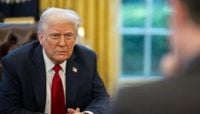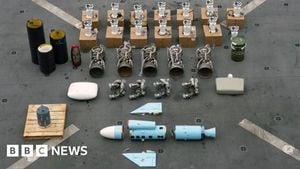On October 17, 2025, the White House in Washington, D.C. became the stage for a high-stakes diplomatic encounter, as U.S. President Donald Trump welcomed Ukrainian President Volodymyr Zelenskyy for what both leaders described as a frank and cordial meeting. The war between Ukraine and Russia, now stretching beyond three and a half years, dominated the agenda, with Zelenskyy arriving in hopes of securing greater U.S. support against Moscow’s ongoing aggression.
Shortly after their discussion, President Trump took to his social media platform, Truth Social, to issue a direct and urgent appeal: "It is time to stop the killing, and make a DEAL! Enough blood has been shed, with property lines being defined by War and Guts. They should stop where they are. Let both claim Victory, let History decide!" The message was unequivocal—Trump wanted both Russia and Ukraine to halt hostilities immediately, freeze the front lines, and allow history to judge the outcome. As reported by Xinhua and the Associated Press, Trump further clarified that he was not advocating a return to Ukraine’s prewar borders, instead suggesting that Moscow could retain the territory it had seized during the conflict.
For Zelenskyy, the stakes were personal and national. Speaking to reporters outside the White House, he acknowledged Trump’s proposal, saying, "I think we have to stop where we are; the president is right." Yet he was quick to add nuance, emphasizing the deep sensitivities around Ukrainian territory now under Russian control. "The question of territories is a very sensitive question, very sensitive and the most difficult really," Zelenskyy remarked, according to Nexstar Media. "But now they want, before any kind of ceasefire, to make a deal about land, about our territories. Our position is that look, first we need ceasefire, so we need to sit and speak and to understand where we are, and I think this is the most important first step."
The day before the White House meeting, Trump had held a lengthy phone call with Russian President Vladimir Putin, which he described as "very productive." According to NBC News, Trump expressed optimism that a deal could be reached, and announced plans to meet Putin in Budapest, Hungary, for further talks aimed at ending the conflict. This would be the second face-to-face encounter between Trump and Putin since their Alaska summit in August 2025, which ended without a breakthrough as ceasefire negotiations remained deadlocked.
Despite the urgency, Trump ruled out the possibility of a U.S.-Russia-Ukraine summit in the near future and downplayed prospects of supplying Tomahawk missiles to Kyiv. As he put it to reporters, "Tomahawks are very dangerous weapons. They’re incredible weapons. If you like warfare. It’s one of the most accurate. Tomahawks are a big deal. But one thing I have to say, we want tomahawks also. We don’t want to be giving away things that we need to protect our country." Still, the mere threat of such weaponry appeared to be influencing Moscow’s calculations, with Trump suggesting that it may be spurring Putin’s willingness to negotiate.
Zelenskyy, for his part, floated the idea of swapping Ukrainian drones for American missiles—a proposal Trump seemed open to. "Yeah, we would," Trump replied when asked if he’d consider the exchange. "We build our own drones, but we also buy drones from others, and they make a very good drone." The Ukrainian president made clear, however, that the first priority was a ceasefire that would allow for meaningful negotiations. "Our position is that, look, first we need cease fire. So we need to sit and speak and to understand where we are," Zelenskyy reiterated.
The question of territory remains the thorniest issue. Trump, who has fluctuated in his public statements about Ukraine’s chances of reclaiming lost land, now appears to leave the door open to land swaps. "You never know," he said when pressed on whether such swaps would be necessary. "You know war is very interesting. You never know." Just weeks earlier, he had suggested that with support from the European Union, Ukraine could potentially restore its original borders, but the tone has shifted toward pragmatism and compromise.
Meanwhile, the war shows no signs of abating on the ground. As NBC News reported, Russia unleashed another heavy barrage of drones and missiles on Ukraine’s power grid, plunging eight regions into blackouts. For Zelenskyy, U.S. assistance—particularly in the form of advanced air defenses and long-range missiles—remains crucial. The Kremlin, however, has warned that such support would mark a sharp escalation, a risk Trump acknowledged when he admitted that allowing Ukraine to strike deep into Russian territory would be "an escalation," but one that would be discussed.
The diplomatic push comes amid a swirl of other political developments in Washington. Trump’s decision to commute the sentence of former U.S. Rep. George Santos, his ongoing trade battles with China, and the looming threat of a government shutdown all vied for attention. Yet, as the images of Trump and Zelenskyy shaking hands at the White House flashed across global newswires, the gravity of the Ukraine conflict—and the possibility of a negotiated peace—remained firmly in the spotlight.
Internationally, the proposed Trump-Putin summit in Budapest is being watched closely. Kremlin spokesman Dmitry Peskov told reporters that preparations were underway, and that Hungary’s unique position as both a NATO and EU member made it a fitting venue. "Such decisions are made together," Peskov said, noting the symbolic weight of the location.
For now, the world waits. Trump’s call for both sides to "claim victory" and let history be the judge is a bold—some say controversial—step toward ending a war that has exacted a heavy toll on both nations. As Zelenskyy put it, "We have to stop where we are, and then to speak. I’m open, as I said, to bilateral, to trilateral, and I don’t know if we have some other formats. I’m open for any kind of formats which can bring us closer to this."
The next few weeks may well prove decisive, as the leaders of the United States, Ukraine, and Russia edge closer—if only tentatively—toward a ceasefire that could reshape the region’s future and, perhaps, offer a glimmer of hope after years of bloodshed.





